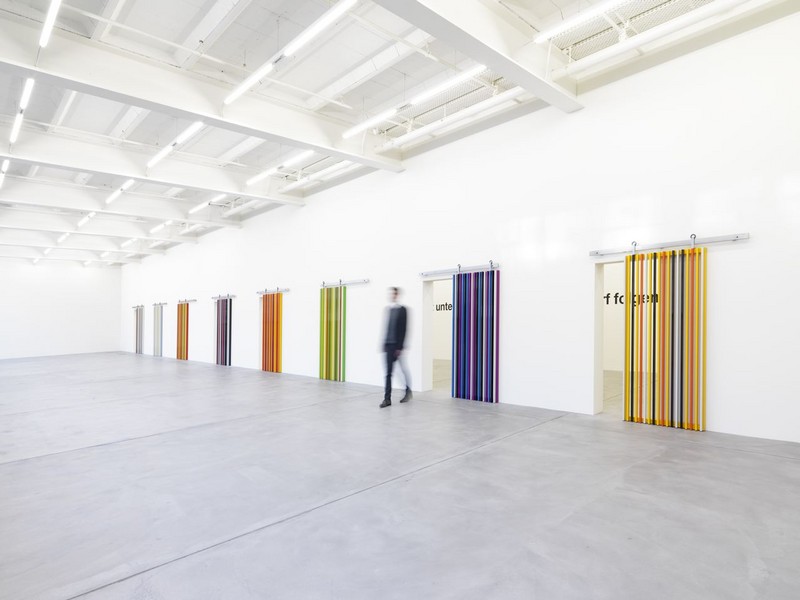Liam Gillick
28 Nov - 27 Dec 2013

Liam Gillick
Installation view at Galerie Eva Presenhuber, Zurich, 2012
(C) Liam Gillick, Courtesy of Galerie Eva Presenhuber, Zurich, TARO NASU, Tokyo
Installation view at Galerie Eva Presenhuber, Zurich, 2012
(C) Liam Gillick, Courtesy of Galerie Eva Presenhuber, Zurich, TARO NASU, Tokyo
LIAM GILLICK
Vertical Disintegration
28 November - 27 December 2013
TARO NASU is pleased to present Vertical Disintegration, by Liam Gillick.
This is his first solo exhibition exhibiting new works with a gallery in Japan.
Liam Gillick
Born 1964, Aylesbury, U.K.
Lives and works in New York.
Has exhibited extensively since 1989 including the 53rd Venice Biennale, The Guggenheim, New York and Documenta X.
The title of the exhibition refers to the organization of production whereby separate entities - formerly part of a whole - take responsibility for specific aspects of production. In other words - a finished object is completed with input from autonomous sources rather than one centralized producer.
This exhibition includes central components of the artist's work over the last twenty years - text, abstract structures and semi-functional objects. A new set of wall mounted fins run across the wall - becoming increasingly disordered. New wall units and rails synthesize an abstraction rooted in applied architecture and secondary forms. These are challenged by two specific texts that are both central works. The first is a quotation from the artist’s book “Literally No Place” (2002) which describes a moment when the main character - on leaving a commune in order to check the surrounding context - has a moment of true engagement with the landscape. The second text “The Any Space Whatever” (2004) is derived from Gilles Deleuze writing on cinema. And became the title of an exhibition at the Guggenheim Museum, New York, in 2008 which brought together a specific group of artists who in the 1990s set about reimagining the exhibition as a form.
The two main spaces of the gallery are dived by a sliding structure that is related to a body of work that addressed some of the genealogical questions raised in Marx’s first attempt to write a comic novel as a young man. The resulting book “Scorpion and Felix” only survives in fragments revealing a mockery of order, organization and delusions of power.
Taken together the works here suggest the multiple points of departure that underscore the recent work.
Vertical Disintegration
28 November - 27 December 2013
TARO NASU is pleased to present Vertical Disintegration, by Liam Gillick.
This is his first solo exhibition exhibiting new works with a gallery in Japan.
Liam Gillick
Born 1964, Aylesbury, U.K.
Lives and works in New York.
Has exhibited extensively since 1989 including the 53rd Venice Biennale, The Guggenheim, New York and Documenta X.
The title of the exhibition refers to the organization of production whereby separate entities - formerly part of a whole - take responsibility for specific aspects of production. In other words - a finished object is completed with input from autonomous sources rather than one centralized producer.
This exhibition includes central components of the artist's work over the last twenty years - text, abstract structures and semi-functional objects. A new set of wall mounted fins run across the wall - becoming increasingly disordered. New wall units and rails synthesize an abstraction rooted in applied architecture and secondary forms. These are challenged by two specific texts that are both central works. The first is a quotation from the artist’s book “Literally No Place” (2002) which describes a moment when the main character - on leaving a commune in order to check the surrounding context - has a moment of true engagement with the landscape. The second text “The Any Space Whatever” (2004) is derived from Gilles Deleuze writing on cinema. And became the title of an exhibition at the Guggenheim Museum, New York, in 2008 which brought together a specific group of artists who in the 1990s set about reimagining the exhibition as a form.
The two main spaces of the gallery are dived by a sliding structure that is related to a body of work that addressed some of the genealogical questions raised in Marx’s first attempt to write a comic novel as a young man. The resulting book “Scorpion and Felix” only survives in fragments revealing a mockery of order, organization and delusions of power.
Taken together the works here suggest the multiple points of departure that underscore the recent work.
